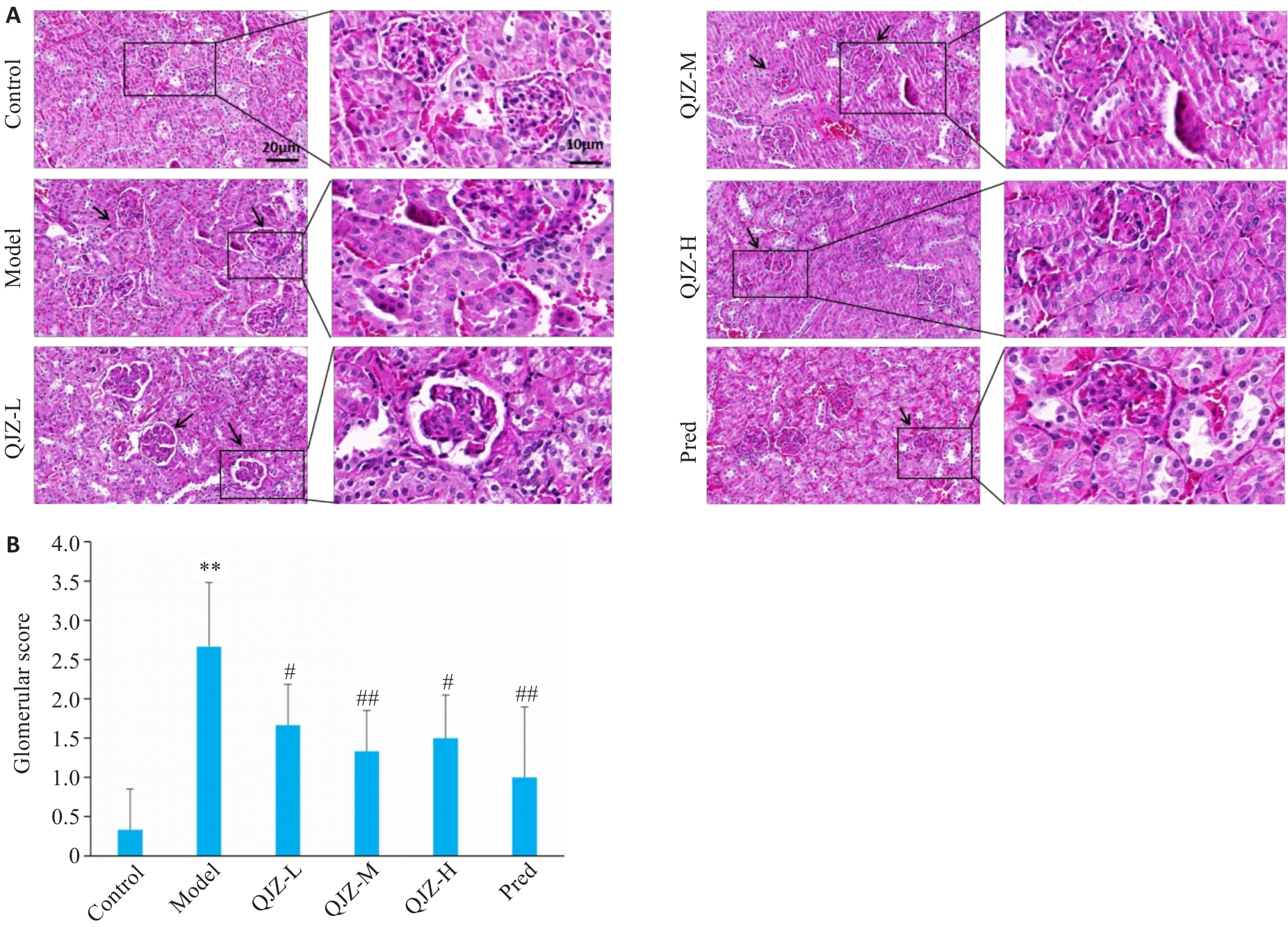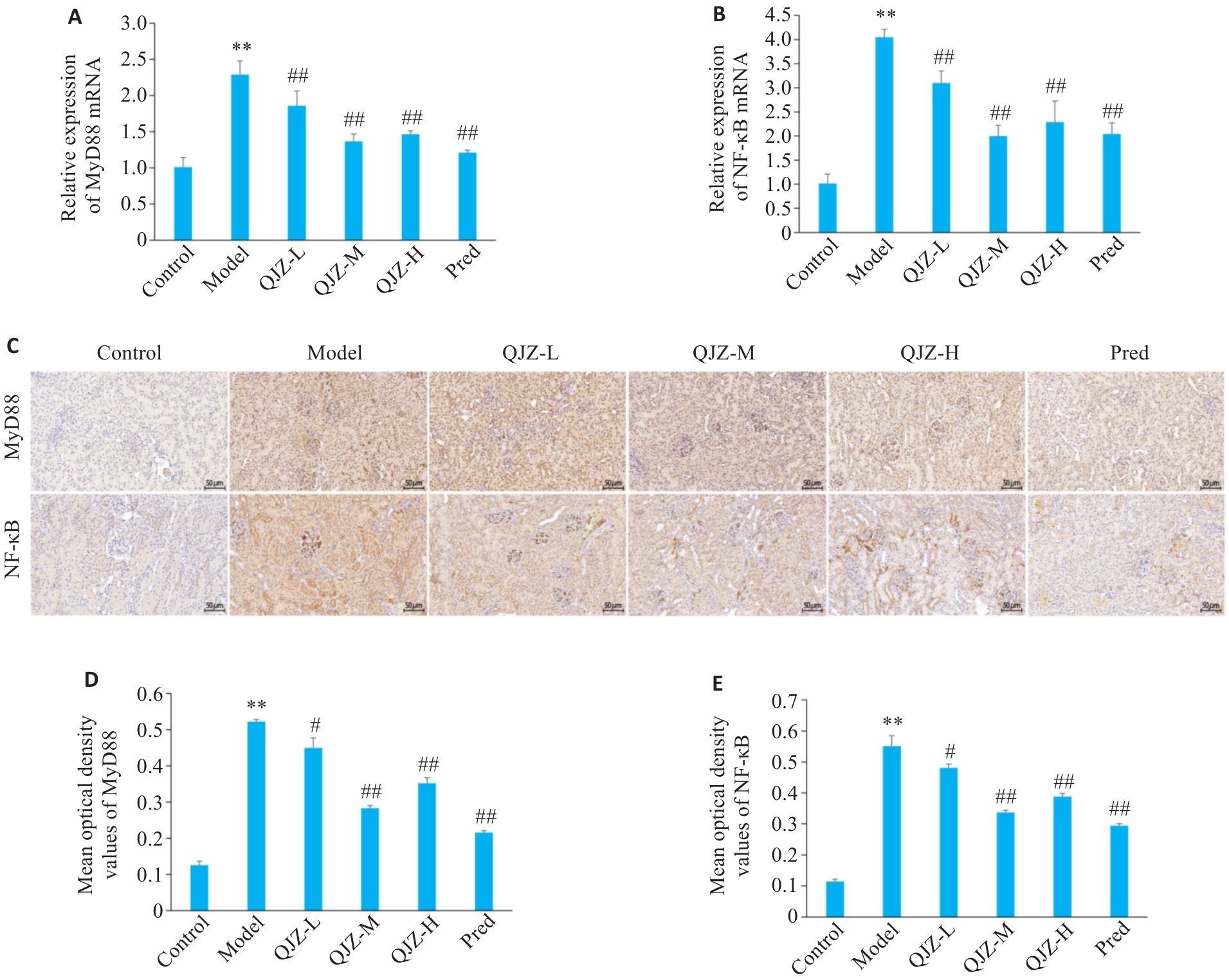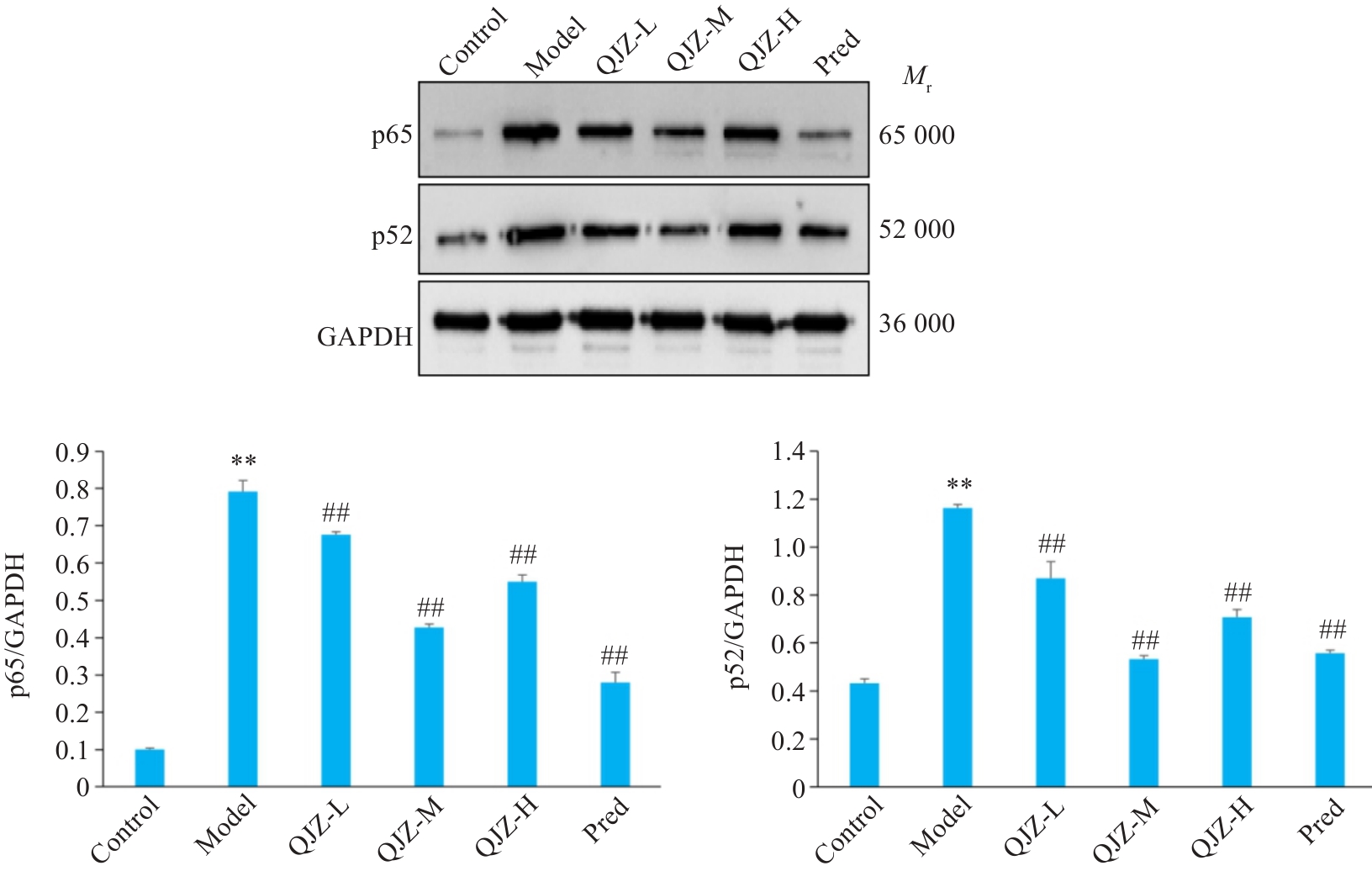南方医科大学学报 ›› 2025, Vol. 45 ›› Issue (8): 1625-1632.doi: 10.12122/j.issn.1673-4254.2025.08.07
• • 上一篇
汤忠富1( ), 黄传兵1,2(
), 黄传兵1,2( ), 李明1,2, 程丽丽1, 陈君洁1, 尚双双1, 刘思娣1
), 李明1,2, 程丽丽1, 陈君洁1, 尚双双1, 刘思娣1
收稿日期:2025-03-06
出版日期:2025-08-20
发布日期:2025-09-05
通讯作者:
黄传兵
E-mail:2835192721@qq.com;chuanbinh@163.com
作者简介:汤忠富,在读博士研究生,医师,E-mail: 2835192721@qq.com
基金资助:
Zhongfu TANG1( ), Chuanbing HUANG1,2(
), Chuanbing HUANG1,2( ), Ming LI1,2, Lili CHENG1, Junjie CHEN1, Shuangshuang SHANG1, Sidi LIU1
), Ming LI1,2, Lili CHENG1, Junjie CHEN1, Shuangshuang SHANG1, Sidi LIU1
Received:2025-03-06
Online:2025-08-20
Published:2025-09-05
Contact:
Chuanbing HUANG
E-mail:2835192721@qq.com;chuanbinh@163.com
Supported by:摘要:
目的 基于MyD88/NF-κB通路探讨芪黄健脾滋肾颗粒(QJZ)改善MRL/lpr小鼠肾损害的作用机制。 方法 6只雌性C57BL/6小鼠为正常对照组(Control组),将30只雌性MRL/lpr小鼠随机分为模型组(Model组)、芪黄健脾滋肾颗粒低剂量组(QJZ-L组)、芪黄健脾滋肾颗粒中剂量组(QJZ-M组)、芪黄健脾滋肾颗粒高剂量组(QJZ-H组)、泼尼松组(Pred组),6只/组。干预8周后取各组小鼠的尿液、全血及肾脏组织,生化试剂盒检测肾损害指标:24 h尿蛋白定量(24 h PRO)、尿总蛋白肌酐比值(UTPCR)、尿蛋白肌酐比(UACR)。ELISA法检测血清中免疫球蛋白G(IgG)、补体3(C3)、补体4(C4)、抗双链DNA抗体(anti-dsDNA)、干扰素γ(IFN-γ)、白细胞介素17(IL-17)。肾脏组织进行HE染色和透射电镜观察肾小球超微结构。采用RT-qPCR、Western blotting和免疫组化法检测肾组织中MyD88/NF-κB通路相关分子的表达。 结果 与Model组相比,QJZ-L、QJZ-M、QJZ-H和Pred组24 h PRO、UTPCR、UACR、IgG、anti-dsDNA、IFN-γ、IL-17降低(P<0.01),C3、C4水平升高(P<0.01)。HE染色结果显示,与Model组比较,各组肾小球内皮细胞增生、系膜增厚减轻。透射电镜显示,各组肾小球电子致密物沉积、炎性细胞浸润较Model组减轻。RT-qPCR和免疫组化结果显示,与Model组相比,QJZ-L、QJZ-M、QJZ-H和Pred组肾脏中MyD88、NF-κB表达下降(P<0.05)。Western blotting结果显示,各组肾脏中p65、p52蛋白水平低于Model组(P<0.01)。 结论 芪黄健脾滋肾颗粒能够改善MRL/lpr小鼠肾损害,其机制可能与抑制MyD88/NF-κB通路过度激活有关。
汤忠富, 黄传兵, 李明, 程丽丽, 陈君洁, 尚双双, 刘思娣. 芪黄健脾滋肾颗粒通过抑制MyD88/NF-κB通路减轻MRL/lpr小鼠肾损害[J]. 南方医科大学学报, 2025, 45(8): 1625-1632.
Zhongfu TANG, Chuanbing HUANG, Ming LI, Lili CHENG, Junjie CHEN, Shuangshuang SHANG, Sidi LIU. Qihuang Jianpi Zishen Granules ameliorate renal damage in MRL/lpr mice by inhibiting the MyD88/NF-κB pathway[J]. Journal of Southern Medical University, 2025, 45(8): 1625-1632.
| Gene | Primer sequence (5'→3') | Length (bp) |
|---|---|---|
| GAPDH | Forward:GCAGTGGCAAAGTGGAGATTG Reverse:CGCTCCTGGAAGATGGTGAT | 169 |
| MyD88 | Forward:TCATGTTCTCCATACCCTTGGT Reverse:AAACTGCGAGTTGGGGTCAG | 175 |
| NF-κB | Forward:GCTCCTGTTCGAGTCTCCAT Reverse:TTGCGCTTCTCTTCAATCCG | 119 |
表1 引物序列
Tab.1 Primer sequences for RT-qPCR
| Gene | Primer sequence (5'→3') | Length (bp) |
|---|---|---|
| GAPDH | Forward:GCAGTGGCAAAGTGGAGATTG Reverse:CGCTCCTGGAAGATGGTGAT | 169 |
| MyD88 | Forward:TCATGTTCTCCATACCCTTGGT Reverse:AAACTGCGAGTTGGGGTCAG | 175 |
| NF-κB | Forward:GCTCCTGTTCGAGTCTCCAT Reverse:TTGCGCTTCTCTTCAATCCG | 119 |

图1 QJZ对各组小鼠24 h PRO、UTPCR、UACR的影响
Fig.1 Effect of Qihuang Jianpi Zishen Granules (QJZ) at low, moderate and high doses (QJZ-L, QJZ-M and QJZ-H, respectively) and prednisone (Pred) on 24-h PRO, UTPCR, and UACR of MRL/lpr mice. **P<0.01 vs Control group (C57BL/6 mice); ##P<0.01 vs Model group. UPCR: Urine protein creatinine ratio; UACR: Urinary albumin creatinine ratio.

图3 QJZ对各组小鼠肾脏病理学的影响
Fig.3 Effect of QJZ on renal pathology in MRL/lpr mice (Left, original magnification: ×40; Right,×100).**P<0.01 vs Control group; #P<0.05, ##P<0.01 vs Model group. A: HE staining; B: Glomerular score.

图4 各组小鼠肾小球超微结构
Fig.4 Transmission electron microscopy for observation of glomerular ultrastructure of the mice in each group (Original magnification: ×25 000).

图5 QJZ对各组小鼠肾组织中MyD88、NF-κB表达的影响
Fig.5 Effect of QJZ on expressions of MyD88 and NF-κB in renal tissues of the mice in each group (Scale bar=50 μm). **P<0.01 vs Control group; #P<0.05, ##P<0.01 vs Model group. A,B:Relative expression of MyD88 and NF‑κB mRNA; C-E: immunohistochemistry results.

图6 QJZ对各组小鼠肾组织中p65、p52蛋白水平的影响
Fig.6 Effect of QJZ on p65 and p52 protein levels in the renal tissues of the mice in each group detected by Western blotting. **P<0.01 vs Control group; ##P<0.01 vs Model group.
| [1] | Zhao G, Li X, Zhang Y, et al. Intricating connections: the role of ferroptosis in systemic lupus erythematosus[J]. Front Immunol, 2025, 16: 1534926. doi:10.3389/fimmu.2025.1534926 |
| [2] | Halfon M, Tankeu AT, Ribi C. Mitochondrial dysfunction in systemic lupus erythematosus with a focus on lupus nephritis[J]. Int J Mol Sci, 2024, 25(11): 6162. doi:10.3390/ijms25116162 |
| [3] | Accapezzato D, Caccavale R, Paroli MP, et al. Advances in the pathogenesis and treatment of systemic lupus erythematosus[J]. Int J Mol Sci, 2023, 24(7): 6578. doi:10.3390/ijms24076578 |
| [4] | Zucchi D, Silvagni E, Elefante E, et al. Systemic lupus erythematosus: one year in review 2023[J]. Clin Exp Rheumatol, 2023, 41(5): 997-1008. |
| [5] | Crow MK. Pathogenesis of systemic lupus erythematosus: risks, mechanisms and therapeutic targets[J]. Ann Rheum Dis, 2023, 82(8): 999-1014. doi:10.1136/ard-2022-223741 |
| [6] | 陈少敏, 李红毅, 刘 炽, 等. 基于CiteSpace的中医药治疗系统性红斑狼疮可视化分析[J].新中医, 2024, 56(24): 184-91. doi:10.13457/j.cnki.jncm.2024.24.037 |
| [7] | 朱雅文, 黄传兵, 李 明, 等. 芪黄健脾滋肾颗粒治疗系统性红斑狼疮患者疗效观察及对外周血Toll样受体表达水平的影响[J]. 中医药学报, 2025, 53(2): 67-71. |
| [8] | 钱 爱, 程园园, 朱雅文, 等.芪黄健脾滋肾颗粒治疗系统性红斑狼疮的疗效观察[J]. 安徽中医药大学学报, 2023, 42(6): 7-12. doi:10.3969/j.issn.2095-7246.2023.06.003 |
| [9] | 李 明, 尚双双, 李云飞, 等. 芪黄健脾滋肾颗粒治疗脾肾亏虚型系统性红斑狼疮的临床疗效观察[J]. 时珍国医国药, 2023, 34(2): 370-3. doi:10.3969/j.issn.1008-0805.2023.02.31 |
| [10] | 陈君洁, 黄传兵, 程丽丽, 等. 芪黄健脾滋肾颗粒调控JAK1/STAT1信号通路对MRL/lpr狼疮小鼠足细胞凋亡的影响[J]. 中成药, 2024,46(12): 4145-50. |
| [11] | Baek WY, Choi YS, Lee SW, et al. Toll-like receptor signaling inhibitory peptide improves inflammation in animal model and human systemic lupus erythematosus[J]. Int J Mol Sci, 2021, 22(23): 12764. doi:10.3390/ijms222312764 |
| [12] | Tao B, Xiang W, Li XL, et al. Regulation of Toll-like receptor-mediated inflammatory response by microRNA-152-3p-mediated demethylation of MyD88 in systemic lupus erythematosus[J]. Inflamm Res, 2021, 70(3): 285-96. doi:10.1007/s00011-020-01433-y |
| [13] | Yang Z, Ji S, Liu L, et al. Promotion of TLR7-MyD88-dependent inflammation and autoimmunity in mice through stem-loop changes in Lnc-Atg16l1[J]. Nat Commun, 2024, 15(1): 10224. doi:10.1038/s41467-024-54674-4 |
| [14] | Tilstra JS, Kim M, Gordon RA, et al. B cell-intrinsic Myd88 regulates disease progression in murine lupus[J]. J Exp Med, 2023, 220(12): e20230263. doi:10.1084/jem.20230263 |
| [15] | 吕冬菊, 黄东明, 段伟静. 黄芪甲苷调控HMGB1/NF-κB通路对脓毒症大鼠巨噬细胞极化和急性肾损伤的机制研究[J]. 中国煤炭工业医学杂志, 2025, 28(1): 1-7. |
| [16] | Reynolds JA, Li Y, Herlitz L, et al. Novel biomarker discovery through comprehensive proteomic analysis of lupus mouse serum[J]. J Autoimmun, 2024, 142: 103134. doi:10.1016/j.jaut.2023.103134 |
| [17] | Chalmers SA, Ayilam Ramachandran R, Garcia SJ, et al. The CD6/ALCAM pathway promotes lupus nephritis via T cell-mediated responses[J]. J Clin Invest, 2022, 132(1): e147334. doi:10.1172/jci147334 |
| [18] | Desai SB, Ahdoot R, Malik F, et al. New guidelines and therapeutic updates for the management of lupus nephritis[J]. Curr Opin Nephrol Hypertens, 2024, 33(3): 344-53. doi:10.1097/mnh.0000000000000969 |
| [19] | 尚双双, 李 明, 黄传兵.健脾滋肾法治疗系统性红斑狼疮的理论探源[J].中国中医基础医学杂志,2023,29(04):663-5. |
| [20] | 钱 爱, 黄传兵, 朱雅文, 等. 基于“肾-脾-肠轴” 探讨健脾滋肾法调节肠道菌群治疗系统性红斑狼疮的可行性[J]. 上海中医药杂志, 2024, 58(12): 52-5, 70. |
| [21] | Tian HY, An LZ, Wang PW, et al. Review of Astragalus membranaceus polysaccharides: extraction process, structural features, bioactivities and applications[J]. Chin Herb Med, 2025, 17(1): 56-69. doi:10.1016/j.chmed.2024.09.004 |
| [22] | 张 慧, 罗进辉, 杨 柳, 等.黄芪多糖调节TGF-β1/Smad/AP-1信号通路对慢性肾衰竭大鼠肾纤维化的影响[J].中国老年学杂志, 2024, 44(16): 4040-4. |
| [23] | 陈鲁宁, 胡 扬, 辛国松, 等. 菟丝子化学成分、药理作用研究进展及其质量标志物(Q-Marker)预测[J]. 中草药, 2024, 55(15): 5298-314. doi:10.7501/j.issn.0253-2670.2024.15.029 |
| [24] | Liu ZH, Xu QY, Wang Y, et al. Catalpol from Rehmannia glutinosa targets Nrf2/NF‑κB signaling pathway to improve renal Anemia and fibrosis[J]. Am J Chin Med, 2024, 52(5): 1451-85. doi:10.1142/s0192415x24500575 |
| [25] | Bailly C. Atractylenolides, essential components of Atractylodes-based traditional herbal medicines: Antioxidant, anti-inflammatory and anticancer properties[J]. Eur J Pharmacol, 2021, 891: 173735. doi:10.1016/j.ejphar.2020.173735 |
| [26] | Ding X, Li S, Huang H, et al. Bioactive triterpenoid compounds of Poria cocos (Schw.) Wolf in the treatment of diabetic ulcers via regulating the PI3K-AKT signaling pathway[J]. J Ethnopharmacol, 2024, 325: 117812. doi:10.1016/j.jep.2024.117812 |
| [27] | 施江南, 温乐乐, 江丽洁, 等. 基于文献计量学的覆盆子研究热点与趋势分析[J].中草药, 2025, 56(2): 598-616. doi:10.7501/j.issn.0253-2670.2025.02.022 |
| [28] | 王 平, 孙文娟, 潘保朝, 等. 基于NLRP3通路研究金樱子抑制肾小管上皮细胞间质化治疗糖尿病肾病的作用机制[J].天津中医药,2024, 41(11): 1468-74. |
| [29] | Chen Y, Tian B. IFN-γ promotes the development of systemic lupus erythematosus through the IFNGR1/2-PSTAT1-TBX21 signaling axis[J]. Am J Transl Res, 2022, 14(10): 6874-88. |
| [30] | Richter P, Macovei LA, Mihai IR, et al. Cytokines in systemic lupus erythematosus-focus on TNF-α and IL-17[J]. Int J Mol Sci, 2023, 24(19): 14413. doi:10.3390/ijms241914413 |
| [31] | Bayer AL, Alcaide P. MyD88: At the heart of inflammatory signaling and cardiovascular disease[J]. J Mol Cell Cardiol, 2021, 161: 75-85. doi:10.1016/j.yjmcc.2021.08.001 |
| [32] | Owen AM, Luan L, Burelbach KR, et al. MyD88-dependent signaling drives toll-like receptor-induced trained immunity in macrophages[J]. Front Immunol, 2022, 13: 1044662. doi:10.3389/fimmu.2022.1044662 |
| [33] | Yu T, Xiaojuan F, Jinxi L, et al. Extracellular HMGB1 induced glomerular endothelial cell injury via TLR4/MyD88 signaling pathway in lupus nephritis[J]. Mediators Inflamm, 2021, 2021: 9993971. doi:10.1155/2021/9993971 |
| [34] | Feng X, Yang R, Tian Y, et al. HMGB1 protein promotes glomerular mesangial matrix deposition via TLR2 in lupus nephritis[J]. J Cell Physiol, 2020, 235(6): 5111-9. doi:10.1002/jcp.29379 |
| [35] | Hövelmeyer N, Schmidt-Supprian M, Ohnmacht C. NF‑κB in control of regulatory T cell development, identity, and function[J]. J Mol Med, 2022, 100(7): 985-95. doi:10.1007/s00109-022-02215-1 |
| [36] | Caster DJ, Powell DW. Precision targeting of NF-κB signaling in lupus nephritis[J]. Lupus: Los Angel, 2020, 6(1): 160. |
| [37] | Chen JS, Chen PH, Song YJ, et al. STING upregulation mediates ferroptosis and inflammatory response in lupus nephritis by upregulating TBK1 and activating NF‑κB signal pathway[J]. J Biosci, 2024, 49(1): 9. doi:10.1007/s12038-023-00381-z |
| [38] | He LY, Niu SQ, Yang CX, et al. Cordyceps proteins alleviate lupus nephritis through modulation of the STAT3/mTOR/NF-кB signaling pathway[J]. J Ethnopharmacol, 2023, 309: 116284. doi:10.1016/j.jep.2023.116284 |
| [39] | Su B, Ye H, You X, et al. Icariin alleviates murine lupus nephritis via inhibiting NF-κB activation pathway and NLRP3 inflammasome[J]. Life Sci, 2018, 208: 26-32. doi:10.1016/j.lfs.2018.07.009 |
| [1] | 陈君洁, 黄传兵, 李 明. 健脾滋肾方抑制系统性红斑狼疮患者的足细胞自噬:基于网络药理学和临床研究[J]. 南方医科大学学报, 2024, 44(3): 465-473. |
| [2] | 李云飞, 庞利君, 束龙武, 李明, 黄传兵. 芪黄健脾滋肾颗粒可改善小鼠系统性红斑狼疮血小板减少:基于Ca2+/CaMKK2/AMPK/mTOR信号通路介导的自噬[J]. 南方医科大学学报, 2024, 44(12): 2327-2334. |
| [3] | 范景如, 张永海, 潘泽群, 王良玉, 洪旭伟, 吴令杰, 郭舜奇. COVID-19患者肺外多器官早期损害的临床分析[J]. 南方医科大学学报, 2020, 40(10): 1518-1524. |
| [4] | 黄雨茜,张 浩,张 双,孙 剑. 维生素D受体与MCP-1在系统性红斑狼疮患者中的表达及意义[J]. 南方医科大学学报, 2020, 40(01): 99-103. |
| [5] | 陈婉乐,刘玉东,李雪兰,冯淑娴,周星宇,马伟旭,黎莹,叶德盛,陈薪,陈士岭. 早发性卵巢功能不全患者赠卵IVF获得妊娠在孕期合并系统性红斑狼疮:1例报告并文献复习[J]. 南方医科大学学报, 2017, 37(12): 1683-. |
| [6] | 张庆,丁澍,张慧琳. 启动子区H3K27me3修饰异常促使系统性红斑狼疮患者CD4+ T细胞CREMα过表达[J]. 南方医科大学学报, 2017, 37(12): 1597-. |
| [7] | 王元元,李洪涛,陆杨,贾孝云,李杨磊,陈升,柴继侠,张佳佳,刘东,谢长好. 甘草酸对MRL/lpr小鼠狼疮性肾炎的治疗作用[J]. 南方医科大学学报, 2017, 37(07): 957-. |
| [8] | 宋秀珍,陈嘉棉,周秋根. 66例系统性红斑狼疮患者的妊娠转归[J]. 南方医科大学学报, 2016, 36(12): 1732-. |
| [9] | 欧阳辉,何雪常,周毅,李朝霞. 系统性红斑狼疮合并带状疱疹病毒感染的免疫抑制[J]. 南方医科大学学报, 2016, 36(11): 1577-. |
| [10] | 聂瑛洁,罗利梅,查艳,孙立,骆辑,潘润桑,田晓滨. 系统性红斑狼疮患者血浆降低间充质干细胞对B淋巴细胞的抑制作用[J]. 南方医科大学学报, 2016, 36(08): 1090-. |
| [11] | 彭宇声,黎 倩,王梦蕾,曹 灿,赖 宽,曾 抗. 碱性亮氨酸拉链转录因子ATF样蛋白在狼疮小鼠肾脏组织中的表达及意义[J]. 南方医科大学学报, 2015, 35(06): 816-. |
| [12] | 章俊,马亚琼,邱敏姿,杨蕾,卜阳,汤珣. 中国汉族TMEM39A基因单核苷酸多态性与系统性红斑狼疮的相关性[J]. 南方医科大学学报, 2014, 34(04): 556-. |
| [13] | 惠海鹏,李开亮,李振彪,汪晶晶,高萌,韩学美. 苯磺酸氨氯地平对老年冠心病患者造影剂相关肾损害的保护作用[J]. 南方医科大学学报, 2012, 32(11): 1580-. |
| [14] | 周志刚,朱美华,梁中锟,陈振瑞,贺微,李长征,谭万龙,姜世勃,刘叔文,周烨,周辰. 系统性红斑狼疮儿童特异性全长抗体基因库的构建与分析[J]. 南方医科大学学报, 2012, 32(08): 1082-. |
| [15] | 何朝生,史伟,叶智明,梁馨苓,章斌,刘双信. 系统性红斑狼疮患者心血管事件发生的回顾调查:879例系统性红斑狼疮横断面研究[J]. 南方医科大学学报, 2011, 31(11): 1910-. |
| 阅读次数 | ||||||
|
全文 |
|
|||||
|
摘要 |
|
|||||